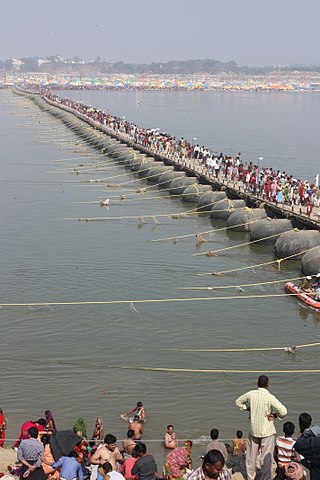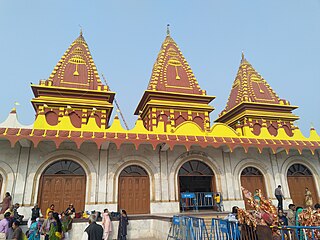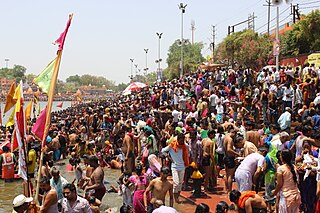
Kumbh Mela or Kumbha Mela is a major pilgrimage and festival in Hinduism. It is celebrated in a cycle of approximately 12 years, to celebrate every revolution Brihaspati (Jupiter) completes, at four river-bank pilgrimage sites: Allahabad, Haridwar (Ganges), Nashik (Godavari), and Ujjain (Shipra). The festival is marked by a ritual dip in the waters, but it is also a celebration of community commerce with numerous fairs, education, religious discourses by saints, mass gatherings of monks, and entertainment. The seekers believe that bathing in these rivers is a means to prāyaścitta for past mistakes, and that it cleanses them of their sins.

Makar(a) Sankranti, also referred to as Uttarayana, Makar, or simply Sankranti, is a Hindu observance and a festival. Usually falling on the date of January 15 annually, this occasion marks the transition of the Sun from the zodiac of Sagittarius (dhanu) to Capricorn (makara). Since the Sun has made this transition which vaguely coincides with moving from south to north, the festival is dedicated to the solar deity, Surya, and is observed to mark a new beginning. Many native multi-day festivals are organised on this occasion all over India.

Guru Amar Das, sometimes spelled as Guru Amardas, was the third of the Ten Gurus of Sikhism and became Sikh Guru on 26 March 1552 at age 73.
Sankranti refers to the transmigration of the sun from one zodiac to another in Indian astronomy.

Vaisakhi, also pronounced Baisakhi as well as Basoa, marks the first day of the month of Vaisakh and is traditionally celebrated annually on 13 April and sometimes 14 April. It is seen as a celebration of spring harvest primarily in Northern India. Further, other Indian cultures and diaspora celebrate this festival too. Whilst it is culturally significant as a festival of harvest, in many parts of India, Vaisakhi is also the date for the Indian Solar New Year. Some 5297 year ago, on this day Raja Shaktikaran Dogra, also known as Raja Shastri, started the Shastri Calendar alias Dogra-Pahari Calendar on this day, so this day has special historical relationship with the Dogras.
The Paripādal is a classical Tamil poetic work and traditionally the fifth of the Eight Anthologies (Ettuthokai) in the Sangam literature. According to Tolkappiyam, Paripadal is a kind of verse dealing only with love (akapporul) and does not fall under the general classification of verses. It has a minimum of 25 lines and a maximum of 400 lines. It is an "akam genre", odd and hybrid collection which expresses love in the form of religious devotion (Bhakti) to gods and goddesses predominently to Maha Vishnu and Murugan. According to Kamil Zvelebil, a Tamil literature and history scholar. This is the only anthology in the Eight Anthologies collection that is predominantly religious, though the other seven anthologies do contain occasional mentions and allusions to gods, goddesses and legends, along with invocatory poem to Shiva.

Maghe Sankranti is a Nepali festival observed on the first of Magh in the Vikram Sambat (B.S) or Yele calendar bringing an end to the winter solstice containing month of Poush. Tharu people celebrate this particular day as new year. It is also regarded as the major government declared annual festival of the Magar community. Maghe Sankranti is similar to solstice festivals in other religious traditions.
Sagar Island is an island in the Ganges delta, lying on the Continental Shelf of Bay of Bengal about 100 km south of Kolkata. This island forms the Sagar CD Block in Kakdwip subdivision of South 24 Parganas district in the Indian State of West Bengal. Although Sagar Island is a part of Sundarbans, it does not have any tiger habitation or mangrove forests or small river tributaries as is characteristic of the overall Sundarban delta. This island is a place of Hindu pilgrimage. Every year on the day of Makar Sankranti, hundreds of thousands of Hindus gather to take a holy dip at the confluence of river Ganges and Bay of Bengal and offer prayers (puja) in the Kapil Muni Temple. Kolkata Port Trust has a pilot station and a light house.

Yātrā, in Indian-origin religions, Hinduism, Buddhism, Jainism and Sikhism, generally means a pilgrimage to holy places such as confluences of sacred rivers, sacred mountains, places associated with Hindu epics such as the Mahabharata and Ramayana, and other sacred pilgrimage sites. Visiting a sacred place is believed by the pilgrim to purify the self and bring one closer to the divine. The journey itself is as important as the destination, and the hardships of travel serve as an act of devotion in themselves.
Fairs in Birbhum refers to the many fairs that take place in Birbhum district in the Indian state of West Bengal.

Maghi is the regional name of the Hindu festival of Makar Sankranti celebrated in Punjab, Haryana Jammu division and Himachal Pradesh. In Himachal, the festival is also known as Maghi Saaji or Magha Ra Saza. In Bihar and Nepal it is also referred to as Maghi Parva or Maghi Sankranti. whereas it is known as Maghi Sangrand or Uttarain (Uttarayana) in Jammu and Sakrat in Haryana, Maghi is celebrated on first day of the month of Magh of Hindu Calendar. It follows on the heels of the mid-winter festival of Lohri which is marked by bonfires in North Indian fields and yards. The next morning Hindus see as an auspicious occasion for ritual bathing in ponds and rivers.

Maghi da Mela (Punjabi: ਮਾਘੀ ਦਾ ਮੇਲਾ ), held at the holy city of Sri Muktsar Sahib each year in January or the month of Magh according to Nanakshahi calendar and it is one of the most important melas or fairs of India and the most important of all religiously significant gatherings of the Sikhs.
Punjabi festivals are various festive celebrations observed by Punjabis in Pakistan, India and the diaspora Punjabi community found worldwide. The Punjabis are a diverse group of people from different religious background that affects the festivals they observe. According to a 2007 estimate, the total population of Punjabi Muslims is about 90 million, with 97% of Punjabis who live in Pakistan following Islam, in contrast to the remaining 30 million Punjabi Sikhs and Punjabi Hindus who predominantly live in India.

Gangasagar is a village and a gram panchayat within the jurisdiction of the Sagar police station in the Sagar CD block in the Kakdwip subdivision of the South 24 Parganas district in the Indian state of West Bengal.

The Jammu division is a revenue and administrative division within Jammu and Kashmir, a union territory of India. It consists of the districts of Jammu, Doda, Kathua, Ramban, Reasi, Kishtwar, Poonch, Rajouri, Udhampur and Samba. Most of the land is hilly or mountainous, including the Pir Panjal Range which separates it from the Kashmir Valley and part of the Great Himalayas in the eastern districts of Doda and Kishtwar. Its principal river is the Chenab.

The Kumbh Mela at Haridwar is a mela held every 12 years at Haridwar, India. The exact date is determined according to Hindu astrology: the Mela is held when Jupiter is in Aquarius and the Sun enters Aries.

Ujjain Simhastha is a Hindu religious mela held every 12 years in the Ujjain city of Madhya Pradesh, India. The name is also transliterated as Sinhastha or Singhastha. In Hindi, the fair is also called Simhasth or Sinhasth. The name derives from the fact that it is held when the Jupiter is in Leo.
The Allahabad Kumbh Mela or Prayag Kumbh Mela, is a mela, or religious gathering, associated with Hinduism and held in the city of Allahabad, India, at the Triveni Sangam, the confluence of the Ganges, the Yamuna, and the mythical Sarasvati river. The festival is marked by a ritual dip in the waters, but it is also a celebration of community commerce with numerous fairs, education, religious discourses by saints, mass feedings of monks or the poor, and entertainment spectacle. Approximately 50 and 30 million people attended the Allahabad Ardh Kumbh Mela in 2019 and Maha Kumbh Mela in 2013 respectively to bathe in the holy river Ganges, making them the largest peaceful gathering events in the world.

The culture of the city of Nashik, in northwestern Maharashtra, is centred around Hindu customs and festivals.













